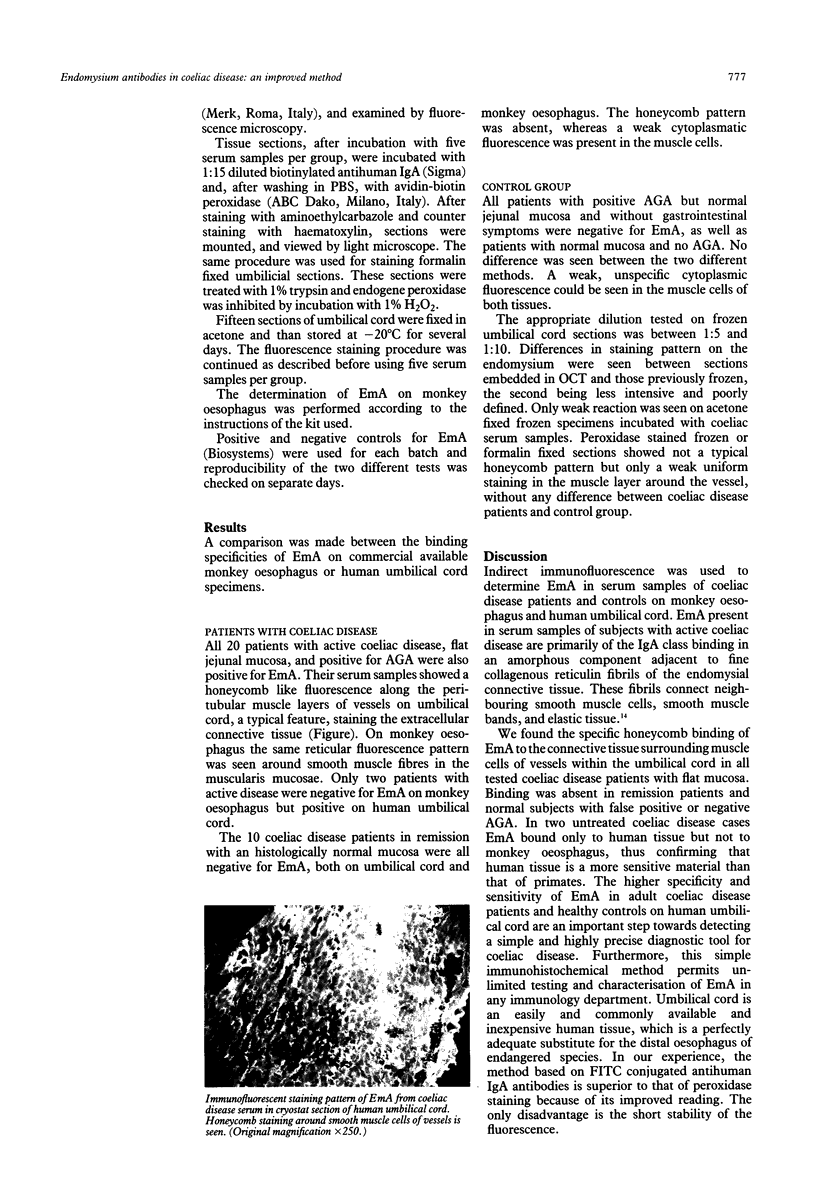Abstract
The ultra structural binding sites of endomysium antibodies have been studied on human umbilical cord tissue. The sensitivity and specificity of IgA endomysium antibodies were compared with recently described methods using basement membrane of smooth muscle of monkey oesophagus. Thirty adults affected by coeliac disease (10 in remission) and 75 healthy adult controls with normal intestinal mucosa (35 false antigliadin positive) were investigated. Sensitivity and correlation of endomysium antibodies with total villous atrophy in untreated coeliac disease patients were 100% on the human umbilical cord smooth muscles, and only 90% on the muscular layer of primate oesophagus. Indirect immunofluorescence was superior to peroxidase staining in detecting these IgA antibodies. The easy availability and enhanced testing sensitivity of the umbilical cord is an advance towards a better diagnostic tool for coeliac disease.
Full text
PDF


Images in this article
Selected References
These references are in PubMed. This may not be the complete list of references from this article.
- Chorzelski T. P., Beutner E. H., Sulej J., Tchorzewska H., Jablonska S., Kumar V., Kapuscinska A. IgA anti-endomysium antibody. A new immunological marker of dermatitis herpetiformis and coeliac disease. Br J Dermatol. 1984 Oct;111(4):395–402. doi: 10.1111/j.1365-2133.1984.tb06601.x. [DOI] [PubMed] [Google Scholar]
- Ferreira M., Davies S. L., Butler M., Scott D., Clark M., Kumar P. Endomysial antibody: is it the best screening test for coeliac disease? Gut. 1992 Dec;33(12):1633–1637. doi: 10.1136/gut.33.12.1633. [DOI] [PMC free article] [PubMed] [Google Scholar]
- Hekkens W. T. Coeliac disease: digestive, immunologic, and nutritional implications. Bibl Nutr Dieta. 1992;(50):58–71. doi: 10.1159/000421889. [DOI] [PubMed] [Google Scholar]
- Kelly C. P., Feighery C. F., Gallagher R. B., Gibney M. J., Weir D. G. Mucosal and systemic IgA anti-gliadin antibody in celiac disease. Contrasting patterns of response in serum, saliva, and intestinal secretions. Dig Dis Sci. 1991 Jun;36(6):743–751. doi: 10.1007/BF01311231. [DOI] [PubMed] [Google Scholar]
- Kárpáti S., Meurer M., Stolz W., Bürgin-Wolff A., Braun-Falco O., Krieg T. Ultrastructural binding sites of endomysium antibodies from sera of patients with dermatitis herpetiformis and coeliac disease. Gut. 1992 Feb;33(2):191–193. doi: 10.1136/gut.33.2.191. [DOI] [PMC free article] [PubMed] [Google Scholar]
- Mantzaris G. J., Rosenberg W. M., Jewell D. P. The immunology of coeliac disease. Springer Semin Immunopathol. 1990;12(2-3):219–229. doi: 10.1007/BF00197507. [DOI] [PubMed] [Google Scholar]
- Marsh M. N. Gluten, major histocompatibility complex, and the small intestine. A molecular and immunobiologic approach to the spectrum of gluten sensitivity ('celiac sprue'). Gastroenterology. 1992 Jan;102(1):330–354. [PubMed] [Google Scholar]
- Revised criteria for diagnosis of coeliac disease. Report of Working Group of European Society of Paediatric Gastroenterology and Nutrition. Arch Dis Child. 1990 Aug;65(8):909–911. doi: 10.1136/adc.65.8.909. [DOI] [PMC free article] [PubMed] [Google Scholar]
- Troncone R., Ferguson A. Anti-gliadin antibodies. J Pediatr Gastroenterol Nutr. 1991 Feb;12(2):150–158. doi: 10.1097/00005176-199102000-00002. [DOI] [PubMed] [Google Scholar]
- Valeski J. E., Kumar V., Beutner E. H., Lerner A., Chorzelski T. P. Immunology of celiac disease: tissue and species specificity of endomysial and reticulin antibodies. Int Arch Allergy Appl Immunol. 1990;93(1):1–7. doi: 10.1159/000235271. [DOI] [PubMed] [Google Scholar]
- Volta U., Molinaro N., Fusconi M., Cassani F., Bianchi F. B. IgA antiendomysial antibody test. A step forward in celiac disease screening. Dig Dis Sci. 1991 Jun;36(6):752–756. doi: 10.1007/BF01311232. [DOI] [PubMed] [Google Scholar]



